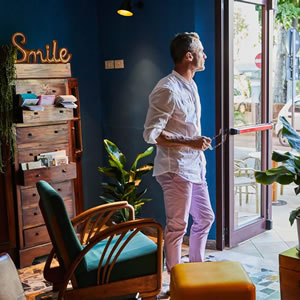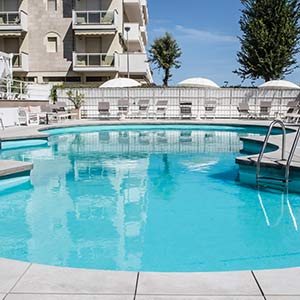The visit to the beautiful town of Rimini can be done following some classic itineraries; divided according to the historical period of relevance, across the entire town, offering breath-taking views and interesting tour to the discovery of the origins of the myth.
ROMAN ITINERARY
It starts along the Tiberius Bridge, a splendid example of a bridge on single foundation made in white Istrian stone that marked (and still marks) the beginning of the via Emilia. Wonderful are the views of the Borgo San Giuliano and of the city park that you can enjoy from the bridge which, especially at sunset, is filled by a wonderful golden light that gives an ethereal dream dimension. Once left the bridge behind, the walk continues toward the city centre to stop again in Piazza Tre Martiri, ancient Roman forum today elected as the lounge of the city, with historical cafés and bars, haute couture boutiques and a charming allure of past times. From there you must visit Porta Montanara, situated at the end of the lively Via Garibaldi, built to protect the only front that was not defended by waters (the one of the mountains to the north).


Art lovers will enjoy a visit to the City Museum, a real mine of wonders and curiosities hosted inside the seventeenth century Jesuits College. Among the finds not to be missed, there are gorgeous mosaics, amphorae and coins and a precious collection of paintings by great painters such as the Guercino and the Ghirlandaio. The itinerary is closed by the imposing Arch of Augustus, symbol of the city par excellence situated at the opposite end of the Bridge of Tiberius, to delimit the end of Corso d'Augusto. 17 meters high and built in white Istrian stone, it offers unforgettable views and intense awesomeness.
Always inside the Roman itinerary, the Domus of the Surgeon and the Roman Amphitheatre complete the visit of the oldest part of the town. The first is a medical clinic perfectly preserved that hosts the most complete collection of instruments for surgical interventions ever found in the world; the second is a former amphitheatre of which are still visible only the ruins of the sea side.
ITINERARY FROM THE MIDDLE AGES TO THE TWENTIETH CENTURY
The itinerary to the discovery of the more recent Rimini starts from Piazza Cavour, the hub of the medieval town surrounded by splendid buildings and monuments such as the Palazzo dell'Arengo, Palazzo del Podestà, the statue of Pope Paul V, the historic Theatre Galli and the legendary Fountain of the Pigna, today the hub of the city life and classic meeting place for the youth of Rimini. The side opposite the Palazzo dell'Arengo is occupied by the old eighteenth-century Fish Market, one of the most characteristic corners of the city with its long counters in stone and the fountains for the cleaning of the fish. The whole surrounding area has recently been reconverted, and the alleys unfolding from the square host today clubs, bars of various kind where you can enjoy the happy hour rite and then continue with the movida up late at night. Walking along via Poletti leaving Piazza Cavour behind, you reach Piazza Malatesta, dominated by the mighty Castel Sismondo, former Renaissance manor today seat of very interesting exhibitions and events.
The Malatesta Temple and the Church of Sant'Agostino complete this second itinerary. The first, a masterpiece of the Italian Renaissance, was built in white marble on a project by Leon Battista Alberti, and hides priceless treasures inside, like the Crucifix by Giotto and a fresco by Piero della Francesca; the second houses splendid frescoes of the Riminese School of the Fourteenth Century.
Rimini, however, is much more. The area of Marina Centro, for example, the central point of the waterfront and the hub of the beach life, is the true soul of the town. Rich in suggestions by Fellini, it houses some of the symbolic places of the town: the Grand Hotel, the more oneiric and cinematographic point of Marina Centro where Fellini used to stay, made of pure Liberty Style; the Park Federico Fellini, green lung of the town; the Fountain of the Four Horses, placed at the centre of the park at the end of the promenade of Viale Principe Amedeo.
Honourable Mention goes to two other places that are symbol of the town, the new Dock and Borgo San Giuliano. The Dock, inaugurated in 2002 to the left of the port, is considered with good reason, one of the most beautiful tourist harbours in the Mediterranean. Equipped with 622 moorings, it is entirely surmounted by a spectacular overhead walkway that offers unforgettable views of great charm and suggestion. Borgo San Giuliano, ancient fisherman district close to the Tiberius Bridge, is a feast for the eyes with its picturesque narrow alleys, the low houses and the walls pastel colour. Pervaded by ancient suggestions Fellini style, it is the ideal place for lazy walks in an atmosphere full of poetry.
Info:
Tourist Information Office (IAT)
Piazzale Fellini, 3 – 47921, Rimini
Tel.: 39 0541 53399















